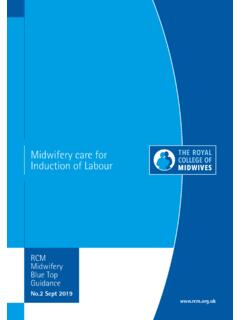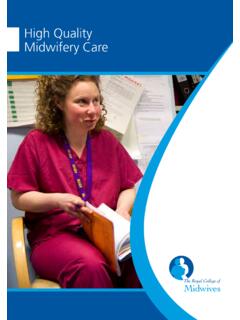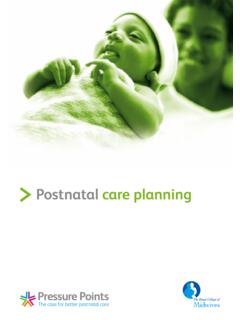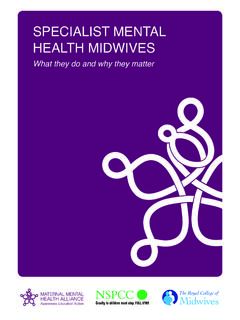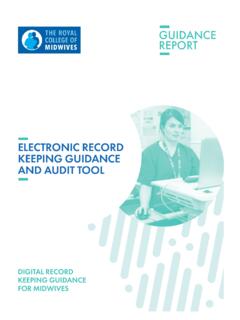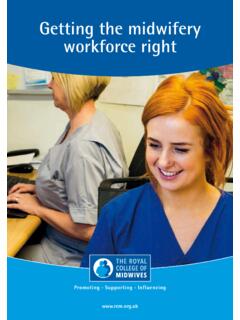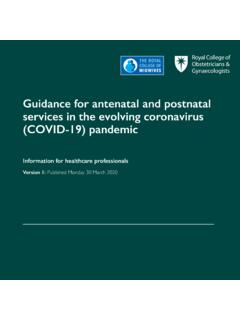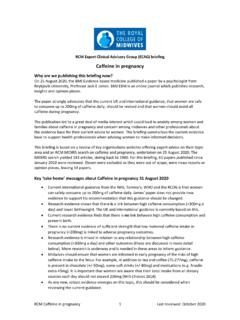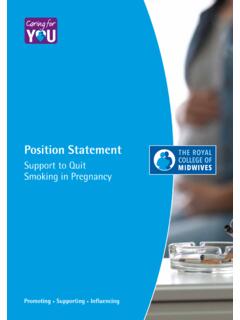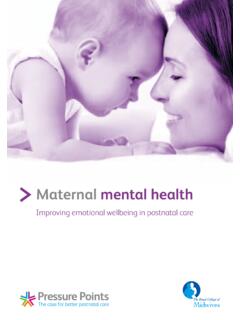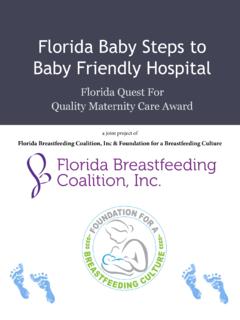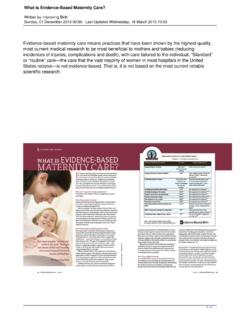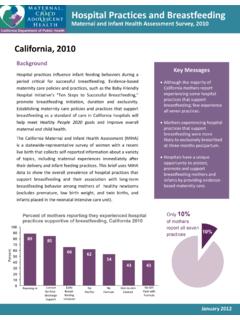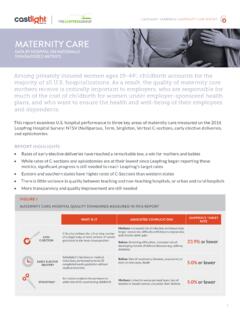Transcription of Evidence Based Guidelines for Midwifery-Led Care in Labour ...
1 Evidence Based Guidelines for Midwifery-Led care in Labour Supporting Women in Labour Practice Points Supporting Women in Labour Studies have suggested four dimensions to the support that women want in Labour : emotional support; informational support; physical support and advocacy (Hodnett et al. 2011; MIDIRS 2008; NICE 2007). All women should receive one to one midwifery support in established Labour (DH 2007;. NICE 2007; RCOG 2007). A woman in established Labour should not be left on her own except for short periods or at the woman's request (NICE 2007). Evidence indicates that continuous support during Labour has a number of measurable positive impacts on key birth outcomes when compared to intermittent support (Hodnett 2011; Scott et ; Zhang et al. 1996). Continuous support is associated with less use of pharmacological analgesia, fewer operative births and fewer reports of dissatisfaction with birth (Hodnett 2011).
2 Support from the midwife may include helping the woman in her wish to avoid pharmacological pain relief or helping her choose among pharmacological and non- pharmacological methods of pain relief (Enkin et al. 2000). The quality of the support may outweigh many other aspects of the birth experience when women describe their satisfaction with their birth, including the number of medical interventions, pain relief and the type of birth (Larkin and Begley 2009; Hauck et al. 2007; Commission for Healthcare Audit and Inspection 2007; Bowers 2002;. Waldenstrom et al. 1996). Poor support and communication during Labour and birth is associated with a higher rate of postnatal mental health problems including postnatal depression and post traumatic stress disorder (Lemola et al.)
3 2007; Creedy et al. 2000; Czarnocka and Slade 2000). Midwives should support women in use of coping strategies (breathing, relaxation and positions) in Labour as use is associated with benefits in terms of pain and women's emotional experiences of Labour (Spiby et al. 2003; Spiby et al. 1999). Midwives should keep up to date with non-pharmacological methods of pain relief. These include water, positions and movement, massage, coping strategies and alternative therapies (Simkin and Bolding 2004; Mander 1998). 2 Evidence Based Guidelines for Midwifery-Led care in Labour The Royal College of Midwives 2012. Supporting Women in Labour Supporting Women in Labour Women in Labour have need for companionship, empathy and help (DH 2004; DH 1993;. Simkin 1992). Descriptive studies of women's childbirth experience have suggested four dimensions to the support that women want in Labour : emotional support, informational support, physical support and advocacy (MIDIRS 2008).
4 Good skills in active listening are essential to supportive midwifery practice. All current national intrapartum practice guidance and maternity policies state that one to one midwifery care should be provided to all women in established Labour (Scottish Government 2011; DH 2007; RCOG 2007; NICE 2007; DH 2004). Women experience a wide range of pain in Labour , and have an equally wide range of responses to it (Mander1998). A woman's reactions to Labour pain may be influenced by the circumstances of her Labour , including the environment and the support she receives (Enkin et al. 2000). Support from the midwife may include helping the woman in her wish to avoid pharmacological pain relief or helping her choose among pharmacological and non-pharmacological methods of pain relief (Enkin et al.)
5 2000). Midwives should keep up to date with non-pharmacological methods of pain relief. These include water, positions and movement, massage, coping strategies and alternative therapies (Simkin and Bolding 2004; Mander 1998). Provision of support during Labour and childbirth is recognised internationally and nationally as a core role of the midwife ( midwifery 2020 2010; NMC 2004, ICM 2005; WHO 1996). Evidence indicates that continuous support during Labour has a number of measurable positive impacts on key birth outcomes when compared to intermittent support (Hodnett 2011; Scott et al. 1999; Zhang et al. 1996). The Cochrane review of continuous versus intermittent intrapartum support carried out a meta-analysis of twenty one randomised controlled trials carried out since 1980 involving over 15,000 women (Hodnett 2011).
6 The impact of continuous support includes a significant reduction in the number of caesarean sections and operative deliveries, an increase in the number of normal births, a reduction in the use of analgesia and a reduction in the length of Labour . It should be noted that none of the randomised controlled trials included in the review were carried out in the UK. The majority of the studies were carried out in highly medicalised systems in which normal care was provided by obstetric nurses rather than midwives, where one to one care was not generally provided and where women were not generally supported by their partners during Labour . In the majority of studies continuous support was provided by doulas' or lay birth supporters rather than by maternity care professionals.
7 No randomised controlled trials have yet been carried out in the UK comparing the different outcomes obtained when continuous support is provided by midwives, lay supporters or doulas'. Research from the US suggests that the support offered to a woman by the nurse or midwife caring for a woman during Labour may have a greater impact than many other variables on the rate of operative deliveries, including maternal age, gestational age, infant weight, antenatal classes and attending physician (Radin 1993). A large body of research with women identifies that the nature of the support given to them during Labour and childbirth is the essential structure' of a positive birth experience (Larking and Begley 2009;. Hauck et al. 2007; Bowers 2002). For women the experience of childbirth and the experience of care are considered as a whole' (Waldenstrom 1996).
8 3 Evidence Based Guidelines for Midwifery-Led care in Labour The Royal College of Midwives 2012. Supporting Women in Labour The quality of the support may outweigh many other aspects of the birth experience when women describe their satisfaction with their birth, including the number of medical interventions, pain relief and the type of birth (Larkin and Begley 2009; Commission for Healthcare Audit and Inspection 2007; Hauck et al. 2007; Bowers 2002; Waldenstrom 1996). Hodnett, in a systematic review of 137 studies exploring women's experiences of birth found four key factors that were so important in women's evaluation of their birth experience that they outweighed the effects of all other variables (age, ethnicity, socio-economic status, birth environment, medical interventions, attendance at antenatal education, pain perception, continuity of care and mobility).
9 These four factors were personal expectations, amount of support from caregivers, the quality of the caregiver- patient relationship and the involvement of the woman in decision-making. This led Hodnett to conclude that The influences of pain, pain relief and intrapartum medical interventions on subsequent satisfaction are neither as obvious, as direct nor as powerful as the influences of the attitude and behaviours of the caregivers (Hodnett 2002). Women's birth experiences have widespread and long-term implications for women and their families. Studies have found women have detailed life-long memories of their births (Simkin, 1991). Poor experiences have been found to contribute significantly to perinatal mental health problems including post-traumatic stress disorder and postnatal depression, undermine the development of a positive mother-baby attachment (Lemola et al.)
10 2007; Creedy et al. 2000; Czarnocka and Slade 2000) and influence women's decisions about future childbearing. Increasingly, women's views of their birth and their memories are being recognised as an important outcome of childbirth (Lavender and Kingdon 2006; Beech and Phipps 2004; NCT 2002). A consensus exists in the literature from theoretical, qualitative, empirical and observational research that intrapartum support consists of four key categories: 1. Emotional support, includes presence, demonstrating an effective caring attitude, positive and calming verbal expressions and non-verbal expressions, distraction, use of humour. 2. Physical support and comfort measures, including environmental control, encouragement of different positions and mobilisation, touch, massage, application of hot and cold packs, hygiene, hydrotherapy, promotion of urinary elimination and nourishment.
